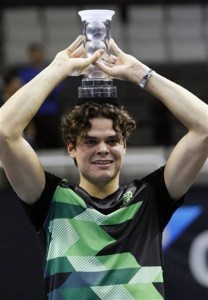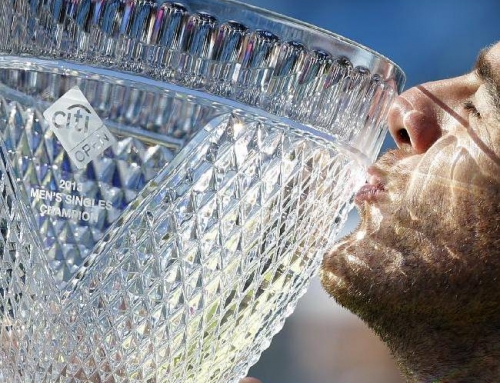 San Jose has to have a special place in Milos Raonic’s heart. In 2011, Raonic made a run at the Australian Open to the fourth round, and everyone thought this Canadian would have places to go. He began to fulfill this promise by reaching the San Jose SAP Open in 2011 shortly afterwards.
San Jose has to have a special place in Milos Raonic’s heart. In 2011, Raonic made a run at the Australian Open to the fourth round, and everyone thought this Canadian would have places to go. He began to fulfill this promise by reaching the San Jose SAP Open in 2011 shortly afterwards.
At the time, he met Fernando Verdasco when Verdasco was still playing decent tennis. He was able to beat Verdasco in two tiebreaks, not terribly unusual for a player like Raonic. He would meet Verdasco again the next week in the first round of Memphis, and would beat Verdasco again.
The following year, Raonic won the title again, this time over Denis Istomin.
This year, Raonic faced Tommy Haas. Haas is the oldest player in the top 30 at 35 years of age. His injuries are legendary. But because he has had so many injuries, he’s a relatively fresh 35 year old without the wear and tear. And he plays an offensive enough style that he’s had pretty good success over the past year. He beat John Isner in the semis while Raonic beat Querrey in the other semi.
Raonic’s weakness, as is the case with most big men, is his return of serve. When you serve as big as Raonic, there’s not a big reason that your return has to be great. Raonic, apparently, has been working on his return of serve. In particular, he’s been working on his down-the-line backhand with pace as a return. When he can nail this, it puts his opponent on defense.
And this was pretty much how be beat Haas. Haas really struggled with returning Raonic’s serve. Indeed, Raonic served 19 aces, a huge amount for a straight set win. Raonic kept getting into Haas’s games, too. Haas had to dig deep to get out of a few service games. Ultimately, he couldn’t stop Raonic. In the last game, Raonic got to 0-40 and eventually clinched a second break.
Final score: 64 63.
As a three time champ, Raonic may have one regret. Two tournaments have been relocated elsewhere. San Jose and Los Angeles are moving outside the US where it’s more profitable. Raonic will be the last San Jose title winner and will need to find a different tournament to play.
As such, he brought both his parents to the tournament so they could watch him play.
Rotterdam
This was one of three tournaments where an older player was trying to beat a younger player separated by more than 5 years. In this case, it was Julien Benneteau. Benneteau already upset the big draw of Rotterdam, the great Roger Federer. He was looking to win his first title after 7 previous losses in finals, but alas, this final was against perhaps his toughest opponent.
Benneteau started off well enough with an early break. That was already an accomplishment as del Potro, his opponent, had not dropped serve in reaching the final. But Benneteau was broken back immediately. Benneteau was trying to move del Potro as welll just as Dimitrov had done in the previous round. And much like the previous round, he made a few too many errors. Worse still, del Potro looked fairly sharp off the ground.
Benneteau had to work hard to hold home of his games, frequently going break points down before digging himself out of a mess.
In the end, it wasn’t enough. He lost 76 63. In the ceremony afterwards, Benneteau thanked his coach, and said they were coming closer to their goal of Benneteau finally winning a tournament. Meanwhile, del Potro seemed genuinely amazed as the sparklers behind him sprayed up as he took his trophy, along with a large bottle of champagne. As the ceremony concluded, Richard Krajicek, tournament director and former Wimbledon winner, pointed out del Potro’s name hanging on the wall of winners as the 2013 winner. After a disappointing Australian Open, del Potro really felt relief from this win.
Sao Paulo
Rafael Nadal continued his second week of play with another return to the final. This time, his opponent was David Nalbandian, a player once good enough that he beat both Nadal and Federer in the same year. Nadal knew he had his work cut out for him, but that Nalbandian is the kind of player Nadal needs to beat on his way back.
The match seemed close for a while, but Nadal was able to break in the middle of the set and then get a second break for a 62 first set win. But then it looked like Nalbandian might make a match of it, going up double break in the second set, 3-0. But just as easily as he took that lead, he gave it up and more, losing 6 consecutive games to lose 63 in the second set, and Nadal won his first title in 2013, and his first since the French Open.
Nadal will take a break for a week and play in Acapulco the week after that.



![[Basel] del Potro wins Basel over Federer for second consecutive year](https://www.essentialtennis.com/wp-content/uploads/2013/10/20131028delpo-500x383.jpg)
![[Stockholm] Dimitrov wins first ATP title with 3-set victory over Ferrer](https://www.essentialtennis.com/wp-content/uploads/2013/10/20131021grigor-500x383.jpg)

![[Metz/St. Petersburg] Simon and Gulbis are champions!](https://www.essentialtennis.com/wp-content/uploads/2013/09/20130922gulbis-500x383.jpg)
